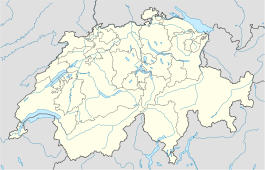- Oberlangenegg
-
Oberlangenegg Country Switzerland Canton Bern District Thun Coordinates 46°47′N 7°43′E / 46.783°N 7.717°ECoordinates: 46°47′N 7°43′E / 46.783°N 7.717°E Population 489 (Dec 2010)[1] - Density 53 /km2 (138 /sq mi) Area 9.15 km2 (3.53 sq mi) Elevation 920 m (3,018 ft) Postal code 3616 SFOS number 0935 Mayor Ueli Jaberg Surrounded by Eriz, Horrenbach-Buchen, Röthenbach im Emmental, Teuffenthal, Unterlangenegg, Wachseldorn Website Oberlangenegg.ch
SFSO statisticsView map of Oberlangenegg Oberlangenegg is a municipality in the administrative district of Thun in the canton of Bern in Switzerland.
Contents
History
Oberlangenegg is first mentioned in 1308 as Langonegga.[2]
Geography
Oberlangenegg has an area, as of 2009[update], of 9.12 square kilometers (3.52 sq mi). Of this area, 4.15 km2 (1.60 sq mi) or 45.5% is used for agricultural purposes, while 4.47 km2 (1.73 sq mi) or 49.0% is forested. Of the rest of the land, 0.42 km2 (0.16 sq mi) or 4.6% is settled (buildings or roads), 0.03 km2 (7.4 acres) or 0.3% is either rivers or lakes and 0.04 km2 (9.9 acres) or 0.4% is unproductive land.[3]
Of the built up area, housing and buildings made up 2.4% and transportation infrastructure made up 1.5%. Out of the forested land, all of the forested land area is covered with heavy forests. Of the agricultural land, 7.8% is used for growing crops and 37.4% is pastures. All the water in the municipality is in rivers and streams.[3]
Demographics
Oberlangenegg has a population (as of 31 December 2010) of 489.[1] As of 2007[update], 1.2% of the population was made up of foreign nationals. Over the last 10 years the population has decreased at a rate of -3.1%. Most of the population (as of 2000[update]) speaks German (97.9%), with Albanian being second most common ( 1.0%) and French being third ( 0.6%).
In the 2007 election the most popular party was the SVP which received 79.2% of the vote. The next three most popular parties were the local small left-wing parties (5.8%), the SPS (4.1%) and the Green Party (3.5%).
The age distribution of the population (as of 2000[update]) is children and teenagers (0–19 years old) make up 28.2% of the population, while adults (20–64 years old) make up 55.6% and seniors (over 64 years old) make up 16.2%. In Oberlangenegg about 58% of the population (between age 25-64) have completed either non-mandatory upper secondary education or additional higher education (either university or a Fachhochschule).
Oberlangenegg has an unemployment rate of 1.17%. As of 2005[update], there were 131 people employed in the primary economic sector and about 42 businesses involved in this sector. 54 people are employed in the secondary sector and there are 5 businesses in this sector. 49 people are employed in the tertiary sector, with 14 businesses in this sector.[4] The historical population is given in the following table:[2]
year population 1764 315 1850 646 1900 648 1950 607 2000 482 References
- ^ a b Swiss Federal Statistical Office - STAT-TAB, online database – Datenwürfel für Thema 01.2 - Bevölkerungsstand und -bewegung (German) accessed 29 September
- ^ a b Oberlangenegg in German, French and Italian in the online Historical Dictionary of Switzerland.
- ^ a b Swiss Federal Statistical Office-Land Use Statistics 2009 data (German) accessed 25 March 2010
- ^ Swiss Federal Statistical Office accessed 17-Jul-2009
Amsoldingen | Blumenstein | Buchholterberg | Burgistein | Eriz | Fahrni | Forst-Längenbühl | Gurzelen | Heiligenschwendi | Heimberg | Hilterfingen | Höfen bei Thun | Homberg | Horrenbach-Buchen | Kienersrüti | Niederstocken | Oberhofen am Thunersee | Oberlangenegg | Oberstocken | Pohlern | Reutigen | Schwendibach | Seftigen | Sigriswil | Steffisburg | Teuffenthal | Thierachern | Thun | Uebeschi | Uetendorf | Unterlangenegg | Uttigen | Wachseldorn | Wattenwil | Zwieselberg
Canton of Bern | Districts of Canton Bern | Municipalities of the canton of Bern
 Categories:
Categories:- Municipalities of Bern
- Municipalities of Switzerland
Wikimedia Foundation. 2010.

